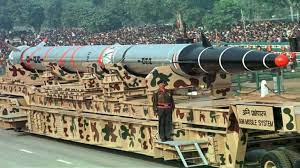Successful Training Launch of Short-Range Ballistic Missile ‘Agni-1’ | 11 Dec 2023
Why in News?
Recently, training launch of Short-Range Ballistic Missile ‘Agni-1’ was carried out successfully from APJ Abdul Kalam Island, Odisha. The launch, carried out under the aegis of the Strategic Forces Command, successfully validated all operational and technical parameters.
What is Ballistic Missile ‘Agni-1’?
- About:
- The Agni-1 is a Short-Range Ballistic Missile (SRBM) developed by India as part of its Agni series of missiles. It is the first missile in the Agni series and is designed to be a strategic weapon capable of carrying a nuclear payload.
- The Agni-1 is primarily intended for use as a deterrent against potential adversaries and is known for its quick response time.
- It is the first variant of the Agni series missiles under Integrated Guided Missile Development Program (IGMDP).
- Technical Specifications:
- The Agni-1 is a single-stage, solid-fueled missile with a range of around 700 to around 1200 kilometers and can carry a payload of 1,000 kg, making it a short-range ballistic missile. It has the capability to carry both conventional and nuclear warheads.
- The solid-fuel propulsion system enhances its operational flexibility and reduces launch preparation time.
- Development and Testing:
- The Agni-1 was developed by the Defence Research and Development Organisation (DRDO) in India. The missile has undergone several successful test launches to validate its performance and reliability.
- Agni-1 was first tested at the Interim Test Range in Chandipur in 1989. The Indian army accepted Agni-1 in service in 2007.
What are the Other Agni Class of Missiles?
The Agni series is a family of ballistic missiles developed by India, with each variant designed for specific ranges and purposes. Besides Agni-1, other notable missiles in the series include:
- Range of other Agni Missiles:
- Agni II: Range more than 2000 km.
- Agni III: Range of more than 2,500 Km
- Agni IV: Range is more than 3,500 km and can fire from a road-mobile launcher.
- Agni-V: The longest of the Agni series, an Inter-Continental Ballistic Missile (ICBM) with a range of over 5,000 km.
- Agni Prime: A two-stage canisterised missile (under development) has been successfully flight tested in June 2023.
- The missile is capable of delivering a number of warheads at separate locations at a distance of 1,000 - 2,000 km.
- ICBMs:
- It is a type of long-range ballistic missile with the capability to travel vast distances, typically intercontinental ranges.
- They play a crucial role in a country's nuclear triad, which includes land-based missiles, submarine-launched missiles (SLBMs), and strategic bombers.
- ICBMs are characterized by their exceptionally long ranges, typically exceeding 5,500 kilometers (about 3,400 miles) and often reaching distances of over 10,000 kilometers (more than 6,200 miles).
- ICBMs follow a ballistic trajectory, meaning they are launched into space before re-entering the Earth's atmosphere to strike their targets.
UPSC Civil Services Examination, Previous Year Questions (PYQs)
Q1. What is “Terminal High Altitude Area Defense (THAAD)”, sometimes seen in the news? (2018)
(a) An Israeli radar system
(b) India’s indigenous anti-missile programme
(c) An American anti-missile system
(d) A defence collaboration between Japan and South Korea.
Ans: (c)
Q2. With reference to Agni-IV Missile, which of the following statements is/are correct? (2014)
- It is a surface-to-surface missile.
- It is fuelled by liquid propellant only.
- It can deliver one-tonne nuclear warheads about 7500 km away.
Select the correct answer using the code given below:
(a) 1 only
(b) 2 and 3 only
(c) 1 and 3 only
(d) 1, 2 and 3
Ans: (a)

